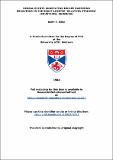Neural events underlying escape swimming behaviour in the squat lobster 'Galathea strigosa' (Crustacea, Anomura)
Abstract
1. The anatomy and physiology of escape swimming behaviour in the
squat lobster, Galathea strigosa, have been investigated and
the results discussed in the context of comparative mechanisms
of escape in rela~ed species.
2. In contrast to many other decapods, G. strigosa, does not possess
a giant-fibre system which underlies escape.
3. In terms of the number, size and position of neuronal somata,
the fast flexor motorneuron pools in Galathea and crayfish are
homologous.
4. A neuron, homologous with the crayfish MeG, has been studied.
Unlike the crayfish neuron, MoGH is a typical, unspecialized
fast flexor motorneuron.
5. The anatomy of afferent and efferent neurons involved in abdominal
extension has been investigated. The extensor motorneuron and
accessory neuron pools in crayfish and Galathea are largely
homologous.
6. A small degree of intersegmental and interspecific variation
in abdominal flexor and extensor motorneuron pools is reported.
7. The anatomy and physiology of the abdominal MRO's has been examined.
These are found to be homologous in structure and function with
other decapod MRO's.
8. The considerable differences between the phasic and tonic MRO
sensory dendrites may account for their different response characteristics.
9. The MRO's excite both extensor motorneurons and the flexor inhibitor
motorneuron via an apparently monosynaptic pathway. Similar
input properties have been described for the crayfish MHO's .
10. The MRO's, which are shown to fire in response to abdominal flexion,
produce EPSP's in extensor motorneurons which both summate and
facilitate. This feature has not been decribed previously and
may be important in the reflex function of the MHO's during escape
swimming behaviour.
11. The relative roles of proprioceptive and exteroceptive feedback
on the generation of the swimming rhythm have been studied using
a variety of preparations involving restraint and deafferenta-
tion.
12. Sensory feedback both excites and inhibits swimming. It is deduced
that proprioceptive feedback has excitatory effects and extero-
ceptive feedback inhibits swimming behaviour.
13. It is suggested that the MHO's may playa role in exciting the
neural circuits underlying swimming bewvbur via both direct
connections with the thoracic nervous system and a restricted
portion of the abdominal motorneuron pool.
14. A deafferented preparation has been used to analyse the motor
programme underlying swimming behaviour. The ability to record
swimming activity, identical with that recorded in the intact
animal, in the absence of sensory feedback from the abdomen,
suggests that swimming behaviour is controlled by a central pattern
generator (CPG).
15. A method of inducing swimming activity by high frequency electrical-
stimulation of abdominal sensori-motor roots is described.
16. The CPG for swimming behaviour is shown to be most likely to
reside in the suboesophageal or thoracic ganglion.
17. The activity of flexor and extensor motorneurons in abdominal
ganglia has been analysed at the cellular level using both extra-
cellular and intracellular recording techniques.
18. Fast flexor motorneurons are driven by a combination of brief
unitary synaptic potentials and a large underlying oscillatory
slow wave depolarization.
19. Current injection into the somata of fast flexor motorneurons
during swimming has dramatic effects on slow wave amplitude and
suggests that motorneuron drive results from powerful periodic
excitation via chemical synapses.
20. In contrast to the fast flexor motorneurons, fast extensor
motorneurons are driven by only brief unitary synaptic potentials
and not by an underlying slow wave depolarization. The contrasting
mechanisms for excitation in antagonistic sets of motorneurons
is documented and a possible explanation presented.
21. Among the fast extensor motorneurons there is an apparent gradation
in spike thresholds which can be correlated with a gradation
in soma diameter. The largest of the available pool of extensor
motorneurons has the highest spike threshold.
22. The activity of the phasic inhibitors of the extensor and flexor
muscles has been analysed. The extensor inhibitor, which fires
in antiphase with other extensor motorneurons during the flexion
phase of the swim cycle, appears to receive the same slow wave
depolarization as fast flexor motorneurons. The extensor inibitor
motorneuron burst is terminated by a high frequency barrage of
IPSP's superimposed upon the membrane slow wave. The flexor
inhibitor motorneuron receives complex excitation and inhibition
during swimming, involving both unitary events and membrane waves.
23. The coordination of segmented limb structures during swimming
has been investigated. The walking legs are physically protracted
during flexion while the unmodified male swimmerets are flicked
posteriorly.
24. Swimmeret retraction during swimming is controlled by the activity
of a single swimmeret motorneuron which appears to be part of
the swimming circuit and which may also be a primitive homologue
of the Segmental Giant neuron in crayfish.
25. It is concluded that escape swimming behaviour is homologous
with non-giant backwards swimming in crayfish and may also be
homologous with swimming in certain sand crab species. The
evolutionary relationships of a number of decapods is discussed
on the basis of escape circuitry and it is suggested that Galathea
may represent an ancestral type of swimming decapod.
Type
Thesis, PhD Doctor of Philosophy
Collections
Items in the St Andrews Research Repository are protected by copyright, with all rights reserved, unless otherwise indicated.

